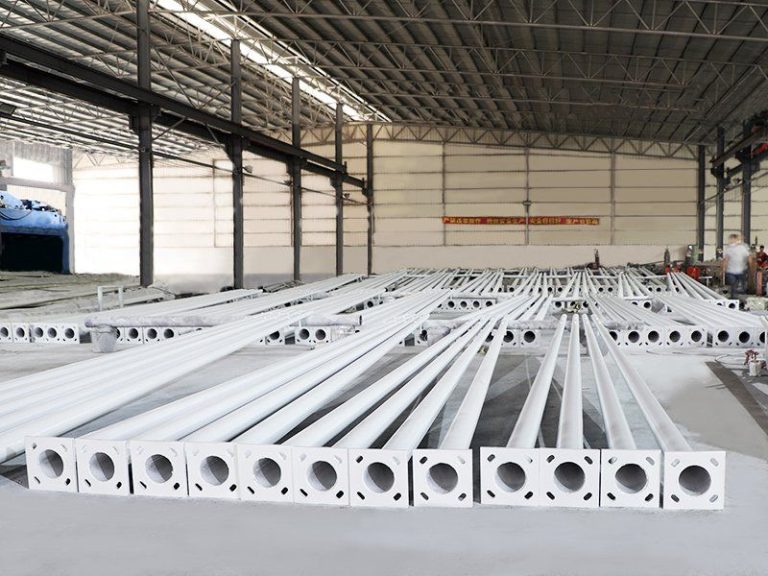Inhoudsopgave
Maximizing Efficiency: How Smart Integrated Solar-powered Street Lighting Fixtures Are Revolutionizing Urban Illumination
In the quest for sustainable and efficient urban infrastructure, the integration of solar-powered street lighting fixtures has emerged as a beacon of innovation. These intelligent systems harness the power of the sun to illuminate our streets, offering a myriad of benefits ranging from reduced energy consumption to enhanced safety. As cities around the world strive to minimize their carbon footprint and maximize efficiency, the adoption of smart integrated solar street lighting systems represents a significant step towards achieving these goals.
One of the key advantages of smart integrated solar-powered street lighting fixtures lies in their ability to operate autonomously, relying solely on solar energy to power their illumination. By utilizing photovoltaic panels to convert sunlight into electricity during the day, these fixtures store the generated energy in rechargeable batteries, ensuring continuous operation throughout the night. This self-sustaining approach not only reduces reliance on traditional grid-based electricity but also mitigates the impact of power outages, making it an ideal solution for areas prone to blackouts or lacking reliable electrical infrastructure.

Furthermore, the integration of smart technology enhances the efficiency and functionality of these solar-powered fixtures. Equipped with advanced sensors and control systems, these lighting solutions can adapt to changing environmental conditions in real-time. For instance, they can adjust their brightness levels based on ambient light intensity, optimizing energy usage while maintaining adequate illumination. Additionally, motion sensors can detect movement in the vicinity, triggering lights to brighten as pedestrians or vehicles approach, thus improving safety and security in urban areas.
The modular design of smart integrated solar street lighting systems allows for seamless integration with existing infrastructure, making installation and maintenance hassle-free. With wireless connectivity capabilities, these fixtures can be remotely monitored and managed, enabling proactive maintenance and troubleshooting. This not only reduces operational costs but also extends the lifespan of the equipment, ensuring long-term reliability and performance.
Moreover, the environmental benefits of smart integrated solar-powered street lighting fixtures cannot be overstated. By harnessing renewable energy sources and minimizing reliance on fossil fuels, these systems help mitigate greenhouse gas emissions and combat climate change. Additionally, their use of energy-efficient LED technology further reduces energy consumption and carbon footprint, contributing to a more sustainable urban environment.
From a financial perspective, the adoption of smart integrated solar street lighting systems offers substantial cost savings over the long term. While the initial investment may be higher compared to traditional grid-connected lighting solutions, the ongoing operational expenses are significantly lower. With no electricity bills to pay and minimal maintenance requirements, municipalities and businesses can recoup their investment relatively quickly, ultimately saving money in the long run.
In conclusion, smart integrated solar-powered street lighting fixtures represent a paradigm shift in urban illumination, offering a sustainable, efficient, and cost-effective alternative to traditional lighting solutions. By harnessing the power of the sun and leveraging intelligent technology, these systems illuminate our streets while minimizing energy consumption, enhancing safety, and reducing environmental impact. As cities continue to embrace innovation in their quest for sustainability, the widespread adoption of smart integrated solar street lighting systems is poised to revolutionize urban lighting infrastructure for years to come.
Sustainable Solutions: Exploring the Benefits of Smart Integrated Solar Street Lighting Systems
In recent years, the pursuit of sustainable solutions has become increasingly imperative in combating climate change and reducing our carbon footprint. Among these solutions, smart integrated solar street lighting systems have emerged as a promising innovation. By combining solar power with intelligent technology, these lighting fixtures offer numerous benefits that contribute to both environmental preservation and efficient urban infrastructure.
At the heart of smart integrated solar street lighting systems lies the integration of solar panels into the street light fixtures themselves. This integration allows for the direct conversion of sunlight into electricity, eliminating the need for traditional grid-based power sources. As a result, these systems significantly reduce reliance on fossil fuels and curb greenhouse gas emissions, making them a pivotal component in the transition towards renewable energy.
Moreover, the smart aspect of these lighting systems sets them apart from conventional street lights. Equipped with advanced sensors and control mechanisms, they are capable of autonomously adjusting their brightness levels based on ambient light conditions. This adaptive functionality not only ensures optimal illumination throughout the night but also maximizes energy efficiency by avoiding unnecessary power consumption during periods of low activity.
Another notable feature of smart integrated solar street lighting systems is their ability to communicate and coordinate with each other through interconnected networks. By forming a cohesive infrastructure, these lights can collectively respond to changing environmental factors and traffic patterns, further enhancing their overall effectiveness and utility. Additionally, remote monitoring and management capabilities enable real-time performance tracking and troubleshooting, facilitating proactive maintenance and minimizing downtime.
Beyond their environmental and operational advantages, smart integrated solar street lighting systems also offer significant cost savings over their traditional counterparts. While the initial investment may be higher, the long-term savings accrued from reduced energy bills and maintenance expenses make them a financially sound investment for municipalities and urban planners. Furthermore, the scalability and modularity of these systems allow for flexible deployment in various urban settings, catering to diverse lighting requirements and spatial constraints.
In terms of societal benefits, the implementation of smart integrated solar street lighting systems can foster safer and more vibrant communities. Adequately lit streets not only deter crime and enhance public safety but also promote social inclusivity and economic development by extending the accessibility of public spaces after dark. Additionally, the aesthetic appeal of these modern lighting fixtures can contribute to the overall ambiance and attractiveness of urban environments, enriching the quality of life for residents and visitors alike.
Looking ahead, the widespread adoption of smart integrated solar street lighting systems holds immense potential to reshape urban landscapes and advance sustainable development goals. As technology continues to evolve and economies of scale drive down costs, these systems are poised to become ubiquitous features of smart cities worldwide. By harnessing the power of the sun and leveraging intelligent design, we can illuminate our streets with efficiency, resilience, and environmental responsibility, paving the way towards a brighter and greener future.
The Future of Urban Lighting: Harnessing the Power of Smart Integration in Solar Street Lighting
The Future of Urban Lighting: Harnessing the Power of Smart Integration in Solar Street Lighting
As urban centers continue to expand and evolve, the demand for sustainable and efficient lighting solutions becomes increasingly pressing. In response to this need, the integration of smart technology with solar-powered street lighting fixtures has emerged as a promising solution. This innovative approach not only addresses the challenges of energy consumption and environmental impact but also offers a range of additional benefits for urban communities.
At the heart of this development is the integration of advanced sensors and control systems into traditional solar street lighting fixtures. These sensors are capable of detecting changes in ambient light levels, motion, and even air quality, allowing for adaptive and responsive lighting solutions. By dynamically adjusting brightness levels based on real-time conditions, smart integrated solar street lighting systems can optimize energy usage while ensuring adequate illumination for pedestrians and vehicles alike.
Furthermore, the integration of wireless connectivity enables remote monitoring and management of individual lighting fixtures. This level of control provides municipalities with valuable insights into energy usage patterns, allowing for more efficient maintenance and troubleshooting. Additionally, it opens up possibilities for future enhancements, such as integrating with other smart city infrastructure or implementing predictive maintenance algorithms to reduce downtime.
| Serial Number | Commodity Name |
| 1 | Integrated Solar Street Light |
One of the key advantages of smart integrated solar street lighting systems is their ability to enhance public safety and security. By incorporating motion sensors and surveillance cameras, these fixtures can detect and respond to suspicious activities in real-time. This not only deters potential criminals but also provides valuable data for law enforcement agencies to investigate incidents more effectively.
Moreover, the environmental benefits of solar-powered lighting are further amplified by the integration of smart technology. By reducing energy consumption and greenhouse gas emissions, these systems contribute to mitigating climate change and improving air quality in urban areas. Additionally, the use of renewable solar energy helps to reduce reliance on fossil fuels, promoting sustainability and resilience in the face of energy shortages or disruptions.
In terms of cost-effectiveness, smart integrated solar street lighting systems offer significant long-term savings for municipalities and urban planners. While the initial investment may be higher than traditional lighting solutions, the reduced energy consumption and maintenance costs result in lower overall operational expenses over the lifespan of the system. Furthermore, the scalability and modular design of these systems allow for easy expansion and customization to meet evolving needs.
In conclusion, the future of urban lighting lies in the smart integration of solar-powered street lighting fixtures. By harnessing the power of advanced sensors, wireless connectivity, and intelligent control systems, these innovative solutions offer a sustainable, efficient, and cost-effective alternative to traditional lighting methods. From enhancing public safety and security to reducing environmental impact and operational costs, the benefits of smart integrated solar street lighting systems are clear. As cities around the world continue to strive for smarter, more sustainable urban environments, investing in these cutting-edge technologies will play a crucial role in shaping the cities of tomorrow.




